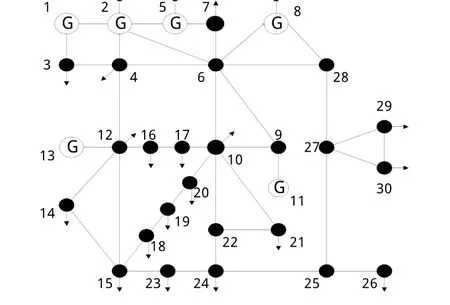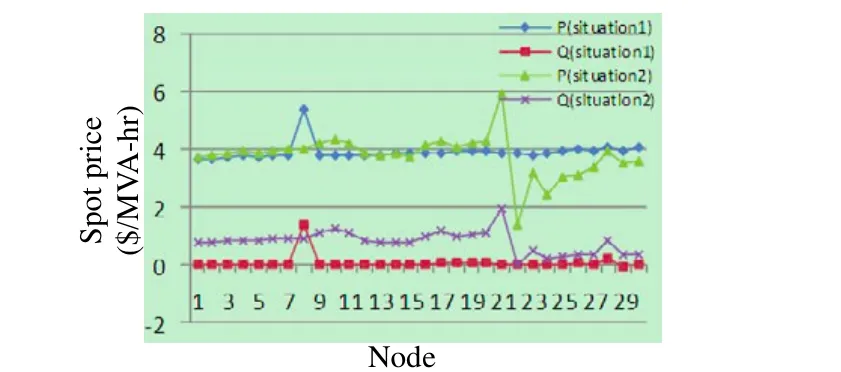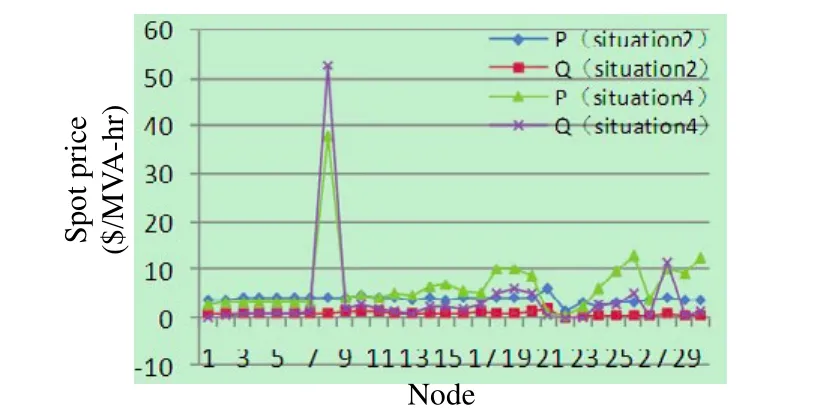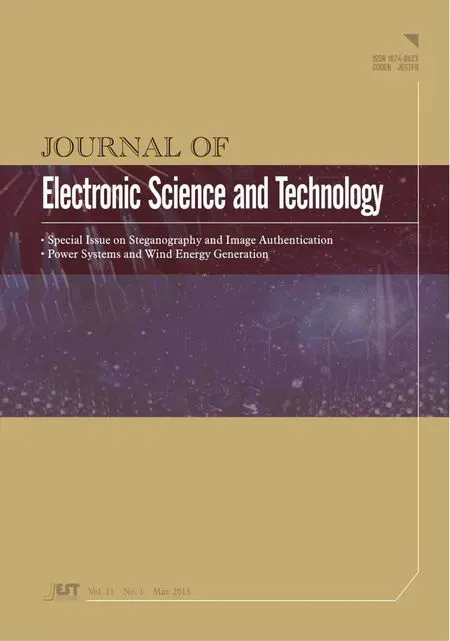Investigation on Active and Reactive Combined Spot Price Integrated with Wind Farm
Zhi-Yang Wu,Xian Guo,and Zhi-Hui Wu
1.Introduction
With the booming power industrialization reform,the electricity market is developing rapidly.Put forward by F.C.Schweppe from Massachu-setts Institute of Technology(MIT)in 1980s for the first time,spot price is arising growing attention,whose research is based on economic dispatch(ED)and direct current power flow(DCPF),and mainly focuses on pricing of active power.In view of the further development of the optimum technology and its practical use,the theory of active power pricing based on optimal power flow(OPF)could provide the signal of optimal price,both enhancing the production efficient and optimizing social interests,and thus has been more widely used.
However,the transition of reactive power ancillary services from unpaid to paid is inevitable.What is more,penalty methods according to power factors are adopted in traditional charging approaches for reactive power,which are hard to satisfy demands of scientific and reasonable pricing,and by which changing ways of the reactive power price with various consumer demands is impossible to provide.As a result,it is of great necessity to consider pricing the reactive power in the spot price model and make active and reactive combined spot price based on possible OPF.
Nevertheless,under the background of energy shortage and environmental pollution,more and more clean and renewable energy,which is environmental friendly,is connected to the grid.However,because of the randomness and intermittence of output power,challenges are faced in obtaining the spot price by calculating OPF.On the basis of the study both at home and abroad,the model of active and reactive combined spot price is built in this paper.Then taking the wind farm as an example,the method of calculating OPF with wind power is studied and the corresponding spot price is analyzed.
2.OPF and Spot Price
2.1 OPF
The core of OPF in a power system is the optimal system operation status,which is realized by optimizing the dispatch of power plants,reactive compensation facilities,and transmission network,satisfying the specific system operation conditions and safety constraints.Since the first introduction of OPF by Dommel and Tinney[1],relevant research has been fulfilled on the aspects of both its mathematical model and solving algorithm[2]-[4].The detailed simulation model and methods of active and reactive combined spot price are studied in this paper,and the algorithm is realized through the Matpower toolbox in MATLAB.
In OPF problems,the optimization target is focused on decreasing generation coal consumption,network loss or other targets,subjected to a series of network constraints,such as the output limits of active and reactive power,output limits of reactive power compensation device,capacity limits of transmission lines,voltage level limits of bus,etc.When the total generation costs reach the lowest,it is the most economical dispatch,in which active and reactive power regulation of generators and reactive power compensation facilities are accomplished.The common algorithm includes linear,nonlinear,quadratic programming,and artificial intelligence algorithm.
2.2 Spot Price
The spot price is the marginal cost of power supply with a given short time range(for example,30 minutes or 15 minutes),taking operation costs into consideration.In the spot price model proposed by F.C.Schweppe[5],the total generation cost and transmission cost are included by adopting spot price,which could be changed with time and nodes location,and accident types and reliability price could also be identified,thus the power price in the electricity market is totally under control.The spot price could be expressed by

where ρk,tis the spot price of the kth consumer in the time interval of t; γ is the generation component,which is consists of marginal fuel consumption costs for generation γF,t,marginal generation maintenance costs γM,t,generation quality costs γQS,t,and power generation balanced payments components γR,t.η represents transmission costs,including marginal network loss costs ηL,t,marginal system maintenance costs ηM,t,quality component of network power supply ηQS,t,and system balanced payments components ηR,t.
It can be concluded from(1)that in the spot price model,system characteristics of operational economy are represented by operation and maintenance costs of power generation and transmission.What is more,the quality of power generation and supply are also considered,which could guarantee safe and steady operation of the system.As a result,as one of the most reasonable pricing methods,the spot price could contribute to lowering generation costs for power industry and provide reasonable arrangements of power plans for consumers largely.
3.Spot Price Based on OPF
As the extension to theory of classical economic dispatch,OPF combines the economy,safety,and output power of the system together.Since the price change caused by a small increase in loads could be represented by the Lagrange multiplier in the node power equation,which shares the same economic meaning with the spot price,an active and reactive power combined model based on OPF can be applied to achieve the spot price.
3.1 Model Description
In order to describe nonlinear programming problems of OPF,corresponding mathematical model should be built,including the nonlinear objective function,nonlinear equation constraints,and inequality constraints.The objective function comprises system generation costs and the constraints include power equilibrium constraints,capacity limits of transmission lines,and so on.The model can be described as

where Pg,Pgmin,and Pgmaxare the rated active power,the minimum active power,and the maximum active power column vectors of generators,respectively; Qg,Qgmin,and Qgmaxare the rated reactive power,the minimum reactive power,and the maximum reactive power column vectors of generators,respectively; V,Vmin,and Vmaxare the rated voltage,the minimum node voltage,and the maximum node voltage column vectors of nodes,respectively; P and Q are active and reactive power flow column vectors of branch,respectively; θ is nodes phase angle vector; Pdand Qdare the active and reactive power flow vectors of load,respectively; H(·)is the vector of branch power flow.
3.2 Solving Algorithm
The concept of PQ-decomposition is introduced in OPF,making it possible to solve optimal problems at a large scale.The objective function and constraints can be divided into two relatively slack associated problems—active power optimization and reactive power optimization,to achieve the decomposition of active power and reactive power.Among them,the object of active power optimization is to decrease costs as far as possible under the assumption of constant system voltage,while minimizing the network loss for reactive power optimization under constant output power.Equation(2)can be decomposed into the sub-problem of active power optimization:

and the sub-problem of reactive power optimization:

where fP(·)(or fQ(·))is the component affected by active power Pg(or reactive power Qg).When solving problems of active and reactive power,Pgand Qgcould be regarded as independent variables.Then the OPF problem is converted to two relatively independent problems,and both can achieve the optimal solution.In general,the two groups of optimal solutions would not be the same under most circumstances; however,they could converge by slight regulation in power flow calculation.
The generation costs of active power can be expressed by quadratic polynomial form:

where G is the nodes set of generators,ak,bkand ckare the corresponding coefficients,and Pkis the output active power .When solving by the interior point algorithm,the corresponding constraints of active optimization is added to the objective function by penalty factors.The optimization function “fmincon” in MATLAB is used in this paper.
Generally,active power of generators is positive and reactive power could be positive or negative.The quoted price of reactive power can be described asand the reactive power generation cost is expressed as

where Qkis the output reactive power.
For generators,benefits can be gained no matter reactive power is positive or not.Since the quoted price of reactive power could be piecewise linear or imitated quadratic polynomial,the latter is adopted in this paper to simplify the analysis.
4.OPF Integrated with Wind Farm
4.1 Output Characteristics of Wind Farm
As one of the renewable clean energy applied at a large scale,wind power is low in generation costs,for no fuel is necessary.However,because of the obvious randomness and intermittence of wind power,the fluctuation of output power has a great effect on the distribution of system power flow[6].
According to statistical laws,wind speed obeys Weibull distribution :

where v represents wind speed(m/s),f(v)is the Weibull function,k and c are the shape coefficient and scale coefficient of the Weibull function,respectively.The steady output power is dependent on that of the single wind turbine,described as

where PWTis the output power of the wind turbine,Pris the rated output power,vciis the cut-in wind speed,vcois the cut-off wind speed,vris rated wind speed,and v is the actual wind speed.
In view of the limits of facility parameters,the output of wind power is not a limitless multiplication of wind speed.When it reaches the cut-in wind speed,the wind turbine starts to work,while the rated output power is remained when the speed exceeds the rated speed.Once the speed is above the cut-off wind speed,the wind turbine stops to prevent the wind turbine from potential damage.In view of changeable wind speed,the AC power is transformed to DC power before inverted to AC power in 50 Hz.
Since the asynchronous motor is applied in the grid-connected wind turbine,large quantity of reactive power is absorbed,and reactive power compensation facility is accordingly equipped.Then the wind turbine is regarded as P-Q nodes,and the reactive power could be described as

Suppose the interaction between wind turbines in the front row and those in the back row is ignored,the output power equals to the sum of the output power of single wind turbine.
4.2 Deal with Wind Farm in OPF Calculation
Determined by natural environment,great uncertainty is possessed by wind speed,making output power of wind turbine random and wave,thus bringing frequency offset,voltage fluctuation,and flicker.Not only technical puzzle is hard to handle with when connected to the grid,but also great challenges are brought to solving problems of OPF and spot price.
Besides disadvantages of itself,wind power has other characteristics.As for the construction cost,it exceeds the traditional power generation a great deal.So incentive policies are implemented to promote wind power at consumer terminal by both American and European countries.However,the subsidy price could be confused with generation costs in traditional OPF.It should be made clear that the most part of subsidy price is to make up for construction costs of wind power,while the marginal generation cost should be set as 0.If wind power could be considered as the load node,then the current load is the output power of wind farm minus the original load capacity Furthermore,the distributed wind turbine is usually connected to the distribution network,making network loss decreased since the output power is consumed locally.It not only saves the costs and realizes optimized operation,but also can verify that it is reasonable to regard the wind turbine and load as being on the same nodes during OPF calculation.
5.Study Case Analysis
The IEEE 30 standard system is adopted in this paper,which is shown as Fig.1.The parameters of the bus,generator,and transmission lines are set according to [7].Suppose the wind speed obeys the Weibull distribution,and the shape coefficient is 2.0,the scale coefficient is 8.5,the cut-in speed is 3.0 m/s,the cut-off speed is 25 m/s,and the rated wind speed is 14 m/s,the rated installed capacity is 600 kW,and the number of wind turbine is 10.The generation cost data is set according to [8].
The optimization model mentioned above is built in MATLAB,in which “fmincon” is applied to solve the optimization model,and the interior point algorithm as the solving methods.Then set 6 different situations(shown as follows)and the corresponding results are shown in Table 1.
Situation 1:not considering pricing reactive power;Situation 2:considering pricing the reactive power;Situation 3:node 8 is connected with the wind turbine as a source; Situation 4:node 21 is connected with the wind turbine as a source; Situation 5:node 24 is connected with the wind turbine as a source; Situation 6:node 17 is connected with the wind turbine as a load.Based on analysis on Fig.2 to Fig.6,conclusions can be drawn as follows:
1)When reactive pricing is taken into consideration,both active and reactive prices have been increased to some degree.The possible reason is that the OPF is re-distributed for the sake of reactive generation costs added into the objective function,making a relatively great change in nodes prices.
2)When the wind farm is connected to the grid as a source node,differences in the price change are observed with different access locations.The minimum change is brought when accessing to node 8; the steady change of most nodes when accessing to node 21; and the greatest change when accessing to node 24.It can be concluded that various levels of voltage changes could be caused by the corresponding variables in access locations.In the practical application of the power flow model,the optimal location of the wind turbine could be achieved in accordance with the interest subject.

Fig.1.Diagram of IEEE 30 standard system.

Fig.2.Spot price of active and reactive of nodes under situation 1 and situation 2.

Table 1:Optimization results of active and reactive combined spot price model under 6 situations(unit:$/MVA-hr)
3)When the wind farm is connected to the grid as a load on node 17,both active and reactive spot prices decrease to a certain degree.It could be explained by the reason that part of the load is balanced by the wind power,and the branch transmission power is decreased,lowering the node price.

Fig.3.Spot price of active and reactive of nodes under Situation 2 and Situation 3.

Fig.4.Spot price of active and reactive of nodes under Situation 2 and Situation 4

Fig.5.Spot price of active and reactive of nodes under Situation 2 and Situation 5.

Fig.6.Spot price of active and reactive of nodes under Situation 2 and Situation 6.
6.Conclusions
Based on the theory of OPF and spot price,the model of active and reactive combined spot price with OPF is built in this paper,and the processing methods of grid-connected wind farms are researched as well.The simulation results of the IEEE 30 standard system in MATLAB show that the spot price calculation can be solved well by OPF,and the wind farm can be regarded as a load node or a source node according to the specific situation.Meanwhile,the optimal access location of wind farms is determined by the optimized object.
[1]H.W.Dommel and W.F.Tinney,“Optimal power flow solutions,” IEEE Trans.on Power Apparatus and Systems,vol.PAS-87,no.10,pp.1866-1876,Oct.1968.
[2]H.H.Happ,“Optimal power dispatch-a comprehensive survey,” IEEE Trans.on Power Apparatus and Systems,vol.PAS-96,no.3,pp.841-854,1977.
[3]J.Catpentier,“Optimal power flows,” Int.Journal of Electrical Power and Energy Systems,vol.1,no.1,pp.3-15,Apr.1979.
[4]O.Alsac and B.Scott,“Optimal load flow with steady-state security,” IEEE Trans.on Power Apparatus and Systems,vol.PAS-93,no.3,pp.745-751,1974.
[5]E.-K.Yu,F.Han,K.Xie,et al.,Electricity Market,Beijing:China Electric Power Press,1988(in Chinese).
[6]Y.-Z.Lei,W.-S.Wang,Y.-H.Yin,et al.,“Optimal real power flow intergrated system,” Power System Technology,vol.26,no.6,pp.18-21,2002(in Chinese).
[7]P.M.Subcommittee,“IEEE reliability test system,” IEEE Trans.on Power Apparatus and Systems,vol.PAS-98,no.6,2047-2054,1979.
[8]K.Y.Lee,Y.M.Park,and J.L.Oritz,“A united approach to optimal real and reactive power dispatch,” IEEE Trans.on Power Apparatus and Systems,vol.PAS-104,no.5,pp.1147-1153,1985.
 Journal of Electronic Science and Technology2013年1期
Journal of Electronic Science and Technology2013年1期
- Journal of Electronic Science and Technology的其它文章
- Design of MEMS C-Band Microstrip Antenna Array Based on High-Resistance Silicon for Intelligent Ammunition
- Low-Cost Embedded Controller for Complex Control Systems
- Data Hiding in DNA for Authentication of Plant Variety Rights
- An Image Authentication Method by Grouping Most Significant Bits
- A Steganography-Based Optical Image Encryption System Using RGB Channel Integration
- Rejection of Direct Blast Interference Based on Signal Phase-Matching Array Processing
